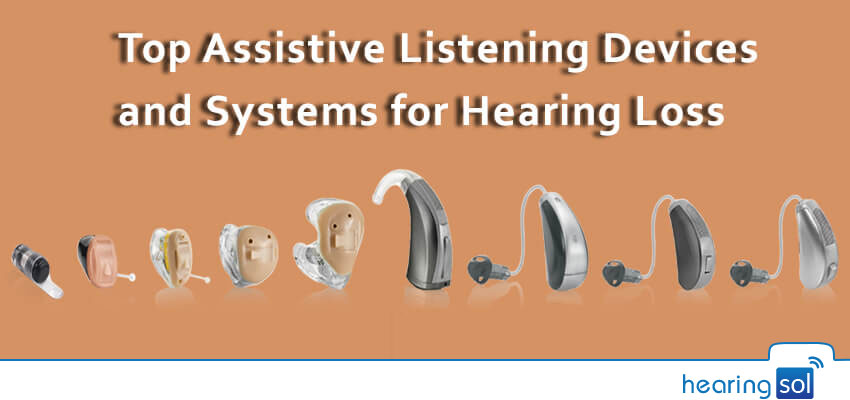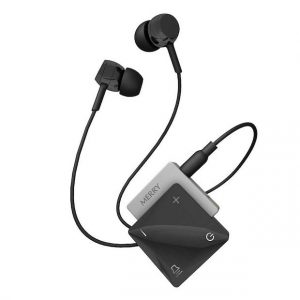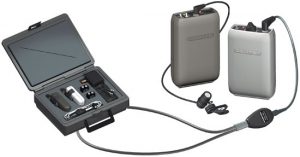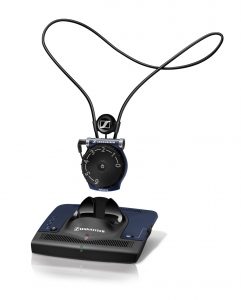
There is no doubt that hearing aid is useful for a person who is hard of hearing. But what if these aren’t enough? Modern Technology has devised some revolutionary equipment that serves as benefits for hearing impaired people.
Here comes in the picture, what we call Assistive Listening Devices (ALD), also known as Assistive Listening Systems.
You can purchase the latest hearing aids at a fair price through HearingSol, If you need any assistance or you have a query regarding Assistive Listening Devices or Hearing Loss, feel free to call us at +91-9327901950. We are always here to help you.
In some situations such as restaurants, huge classroom settings, or even places with poor acoustics, shortcomings of hearing aids are exposed; then comes in ALD.
As such places have ambient noise and require some extra boost. ALDs are responsible to bring the sound closer to the listener’s ear.
This improves the speech-noise ratio, as well as separate the sound to be heard, from the unwanted background noise. This ultimately improves the user’s listening experience.
Generally, a hard of hearing person requires an increased volume of about 15 to 25 decibels to achieve a normal hearing level. This is achieved by ALD without even disturbing others in the vicinity.
In some situations, these devices can be used with hearing aids or cochlear implants and even separately if slight amplification is needed.
There are many ALDs available in the market with certain advantages of their own in different situations. This is helpful in making hearing aid much more effective and also rounding out the hearing aid experience.
Assistive Listening Devices
Assistive Listening Systems (ALS) are on occasion called Assistive Listening Devices (ALDs). Each component of assistive hearing devices has unique features and functions.
They involve the complex mechanism or process in order to enhance the hearing capacity.
ALDs gadgets refer to a number of kinds of amplification tools designed to improve the verbal exchange of individuals with the difficulty of hearing to decorate the accessibility to speech signals when person hearing gadgets are now not sufficient.
ALDs differ in their inner electronic mechanisms ranging from simple hard-wire microphone-amplifier gadgets to more state-of-the-art broadcasting systems.
Since Assistive Listening Devices particularly can expand the effectiveness of the listening to aids and cochlear implants, they can make massive differences in alleviating the daily grind of hard of listening to (HOH) persons and make hearing less difficult and consequently enhance their existence quality.
Why Are Assistive Listening Devices Necessary?
Research suggests that people who are challenging of hearing require a volume (signal to noise ratio) expand of about 15 to 25 dB in order to gain the same level of grasp as humans with everyday hearing.
An ALS permits them to achieve this attain for themselves besides making it too loud for absolutely everyone else.
Types Of Assistive Listening Devices
There is a broad range of assistive listening devices available in the market. All of which have their own benefits in different situations. They help to spherical out the hearing aid experience and make them more effective.
There are many distinct ALDs on the market, here are five in particular which are the most popular:
1. Personal Amplifier
This ALD device is mostly used for one to one conversation. It consists of a box of the size of a cell phone with a mic and an attached listening cord.
This can be attached to the clothing of the person you are talking to, then plug it into the personal amplifier and hear clearly.
This process cuts out most of the background noise.

Personal amplifiers are different from hearing aids. You will come to know about the differences between amplifiers and hearing aids after you use them separately.
The downside of this device is that it cannot be useful in situations when you are required to move around a lot, as it has a wired connection with the speaker.
Situations such as concerts or theaters, which require mobility or hearing from a distance, will need a more flexible system. But this device can be useful in situations like watching TV, being outdoors, or traveling in a car.
Some of the personal amplifiers come with directional microphones. It can be angled towards the speaker or the source of the sound.
In other ALDs, the amplified sound is picked up by the receiver that the listener is wearing either by a headset or earbuds.
2. FM Systems

This ALD somehow overcomes the limitations of personal amplifiers as it allows mobility in addition to, hearing a more distant sound. FM System uses Radio Broadcast Technology which brings sound directly to the ear.
This is a wireless device making its receiver portable which facilitates hearing the speaker. The speaker has to wear a microphone transmitter, which allows listening up to 150 feet away.
This ALD is suitable for classroom or outside setting as it allows mobility at will and still able to hear the distant sound clearly.
But for this added flexibility, you have to pay the added amount, which costs up to Rs 48,489 to Rs 69,270 on an average.
How FM Assistive Listening Devices Are Used?
This system can be used in the classroom setting where the instructor wears a small microphone connected to a transmitter. The students have to wear the receiver tuned to a specific frequency or channel.
Those having a built-in telecoil in their hearing aid or cochlear implant may also wear a wire around their neck (i.e. neck loop) or behind their aid or implant (silhouette inductor).
This converts the signal into magnetic signals to be picked up directly by telecoil or t-coil. FM can transmit signals up to 300 feet.
As radio signals can penetrate walls, the listener in both rooms needs to listen to different channels to avoid receiving mixed signals.
FM System can also be used on a personal level, in the same way, it is operated on a larger system. This can help people with hearing a loss to follow one to one conversations.
Miniaturized receivers can be utilized in newer FM Systems that fit onto a hearing aid via a “boot”. This receiver is not available through the catalog.
This device must be dispensed by hearing aid professional and it is more expensive as compared to traditional FM Systems. It uses a high frequency which makes it incompatible with other FM devices.
3. Infrared Systems
In this system, light-based technology or infrared lights are used to transmit sound. Their working is similar to the FM System. This high-tech system guarantees privacy while talking as lights cannot travel through walls.
It will be very useful in situations like a doctor’s office, court proceedings, etc. They are often used in places of entertainment i.e. while watching TV or in theaters, and also where competing signals can be a problem.
Limitations Of Infrared Systems
The signal gets blocked if any object or character comes in between the listener and the emitter. However, this device can’t be used in a surrounding with too many light sources such as in sunlight or strongly lit room.
Thus making this machine appropriate for some situations, and now not as versatile as FM System.
4. Induction Loop Systems

Those having built-in telecoils in their hearing aids have an alternate option; an induction loop system. This system uses an electromagnetic field to carry sound to the user’s ear.
This loop system consists of four parts:
- A sound source, i.e. public address system, microphone, TV or telephone
- Amplifier
- A thin loop of wire that encircles the room and branches out beneath carpeting
- A receiver is worn in the ear or as a headset
Hearing loops can also be connected to a public address system, TV, or any other audio source.
The system consists of an insulated wire. This wire can range from a small loop to (worn around the neck) to the loop that encircles the entire room is connected to a power source, an amplifier, and a microphone.
This system is inexpensive as well as versatile and is used for a single telecoil hearing aid user or a group. Since the user is not directly connected to the system, mobility is not an issue.
Loop system can be used by even non-hearing aid users, with the headphone or receiver system.
An electromagnetic field is created by the amplified sound traveling through the loop. This field is picked up directly by the hearing loop receiver or t-coil, the built-in miniature wireless receiver of hearing aid as well as cochlear implants.
The listener must be wearing the receiver and stay around the loop, to pick up the signal. As the sound is directly picked up by a receiver, it is very clear, free from the background noise associated with many listening environments.
If a person doesn’t have a hearing aid with embedded telecoils, then not to worry, portable loop receivers are also available.
These portable loops made it possible for people with hearing loss to improve their listening environment so that they can proceed with their daily activities.
5. Sound Field System
This is a speaker system often used in schools that brings the sound closer to the ears. This system is useful for people with a mild hearing loss as well as those who want to use hidden speakers.
Some of these hidden speakers are wireless, resembling a lunch box or books. This sound system can be used for hearing by both hearing aid wearers as well as cochlear implants users, through the microphone.
The use of a sound field system is the concept of “electronic curb cut”. This is one of the most interesting features of this system.
Bluetooth
Bluetooth technology is the latest innovation for hearing aid wearers. But these are not yet available. Using this technology, two devices such as cell phones or computers and wireless hearing aid can be connected, with a compatible streamer to talk to each other.
Though it’s range is limited, around 20 feet. But with no interference and secure connection of this convenient hands-free technology, one can overcome all its flaws.
Using only one streamer can allow the user to switch back and forth among multiple devices i.e. phones, tablets, or iPods.
These assistive devices can be really helpful in your day to day life. Especially if you are a hearing aid wearer or a cochlear implant user.
This can certainly boost up your hearing experience. Based on the features and requirements, decide which of the above Assistive Listening Device is right for you and your lifestyle.
How Listening Devices Are Different From Hearing Aids?
Today, assistive listening devices and hearing aids both contribute to better hearing. Well, both are wearable sound-amplifying devices and they look alike, similar functions with advanced component functions.
They have a pivot role in making communication better. But still, they are not the same and you have to understand these differences.
Assistive listening devices and hearing aids both have almost similar functions but they can’t replace each other. Lets study about their quiet differences :
Listening Devices Vs Hearing Aids
Listening Devices refer to the gadgets used in the amplification of sounds that are low and far to the listener. It helps the amplified sounds to reach the user’s ear.
On the other hand, hearing aids are the tiny computers that the audiologists fit in the user’s ear for better hearing.
Listening devices can be used by normal people to amplify the sounds or make the sounds louder. But the people using hearing aids have a hearing impairment.
Hearing aids assist people who are suffering from hearing problems like hearing loss, tinnitus, etc.
According to the advertisers, though sound amplifiers or listening devices are less expensive than hearing aids they can’t replace them. As FDA has only approved hearing aids for medical purposes but not listening devices.
Hearing is not sound boosters, unlike listening devices. Listening devices help amplify the sounds a person wants to hear, especially where there’s a lot of background noise.
They can be used with a hearing aid or cochlear implant to help a wearer hear certain sounds better. They are the extra sound booster. We can use them with or without hearing aids. It helps people to hear better.
Hearing Aids differentiate between sounds and amplify them based on the characteristics of that sound but listening devices amplify the sounds and make it louder.
They are programmed to make speech easier to hear and decipher. Plus, an audiologist can make adjustments to the hearing aid to optimize your ability to hear.
Hearing aids needs fitting of the user’s ear as the type of hearing aids depend upon the user hearing impairment. It should be comfortable when one wears it. While personal sound amplifiers are “one size fits all.”
Are ALSs Required?
Wide vicinity ALSs are protected below Title III of the Americans with Disabilities Act (ADA). This title stipulates that ALSs be furnished in public places except a provider can prove that it is an undue burden.
Examples of such venues include film theaters, stay performance theaters, and public classes.
You can purchase the latest hearing aids at a fair price through HearingSol, If you need any assistance or you have a query regarding Assistive Listening Devices or Hearing Loss, feel free to call us at +91-9327901950. We are always here to help you.

 Reviewed by Mr. Ranjeet Kumar
Sr. Audiologist, Speech Therapist & Cochlear Implant Specialist, BASLP on
Reviewed by Mr. Ranjeet Kumar
Sr. Audiologist, Speech Therapist & Cochlear Implant Specialist, BASLP on